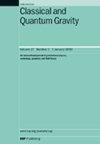Extension of the characterization of non-Gaussianity in gravitational wave detectors with a statistical hypothesis test
IF 3.6
3区 物理与天体物理
Q2 ASTRONOMY & ASTROPHYSICS
引用次数: 0
Abstract
In gravitational wave (GW) astronomy, non-Gaussian noise, such as scattered light noise disturbs stable interferometer operation, limiting the interferometer’s sensitivity, and reducing the reliability of the analyses. In scattered light noise, the non-Gaussian noise dominates the sensitivity in a low frequency range of less than a few hundred Hz, which is sensitive to GWs from compact binary coalescence. This non-Gaussian noise prevents reliable parameter estimation, since several analysis methods are optimized only for Gaussian noise. Therefore, identifying data contaminated by non-Gaussian noise is important. In this work, we extended the conventional method to evaluate non-Gaussian noise, the Rayleigh statistic, by using a statistical hypothesis test to determine a threshold for non-Gaussian noise. First, we estimated the distribution of the Rayleigh statistic against Gaussian noise, called the background distribution, and validated that our extension serves as the hypothetical test. The threshold on the Rayleigh statistic is estimated at 0.73 and 1.28 when the significance level is 0.05, and the sample size is 39. Moreover, we investigated the detection efficiency by assuming two non-Gaussian noise models. For example, for the model with strong scattered light noise, the true positive rate (TPR) was always above 0.7 when the significance level was 0.05. For the demonstration, we applied our extension with the estimated thresholds to the real data. We confirmed our extension provides the binarized outputs of the statistical tests and contributes to finding the non-Gaussian noise in the real data. The results showed that our extension can contribute to an initial detection of non-Gaussian noise and lead to further investigation of the origin of the non-Gaussian noise.用统计假设检验扩展引力波探测器的非高斯性特征
在引力波(GW)天文学中,散射光噪声等非高斯噪声干扰了干涉仪的稳定运行,限制了干涉仪的灵敏度,降低了分析的可靠性。在散射光噪声中,非高斯噪声在小于几百赫兹的低频范围内主导着灵敏度,而这正是对来自紧凑双星凝聚的 GW 非常敏感的地方。这种非高斯噪声妨碍了可靠的参数估计,因为有几种分析方法只针对高斯噪声进行了优化。因此,识别被非高斯噪声污染的数据非常重要。在这项工作中,我们通过使用统计假设检验来确定非高斯噪声的阈值,从而扩展了评估非高斯噪声的传统方法--瑞利统计量。首先,我们估计了雷利统计量在高斯噪声下的分布(称为背景分布),并验证了我们的扩展可作为假设检验。当显著性水平为 0.05、样本量为 39 时,瑞利统计量的阈值估计为 0.73 和 1.28。此外,我们还通过假设两种非高斯噪声模型来研究检测效率。例如,对于强散射光噪声模型,当显著性水平为 0.05 时,真阳性率(TPR)始终高于 0.7。为了进行演示,我们将带有估计阈值的扩展应用于真实数据。我们证实,我们的扩展提供了统计检验的二值化输出,有助于发现真实数据中的非高斯噪声。结果表明,我们的扩展可以帮助初步检测非高斯噪声,并进一步调查非高斯噪声的来源。
本文章由计算机程序翻译,如有差异,请以英文原文为准。
求助全文
约1分钟内获得全文
求助全文
来源期刊

Classical and Quantum Gravity
物理-天文与天体物理
CiteScore
7.00
自引率
8.60%
发文量
301
审稿时长
2-4 weeks
期刊介绍:
Classical and Quantum Gravity is an established journal for physicists, mathematicians and cosmologists in the fields of gravitation and the theory of spacetime. The journal is now the acknowledged world leader in classical relativity and all areas of quantum gravity.
 求助内容:
求助内容: 应助结果提醒方式:
应助结果提醒方式:


